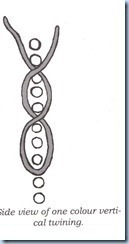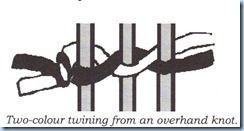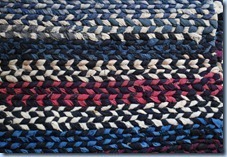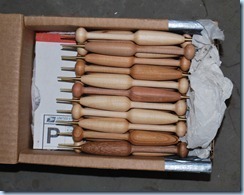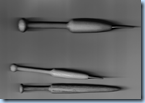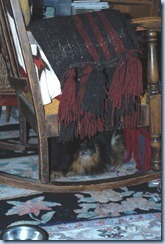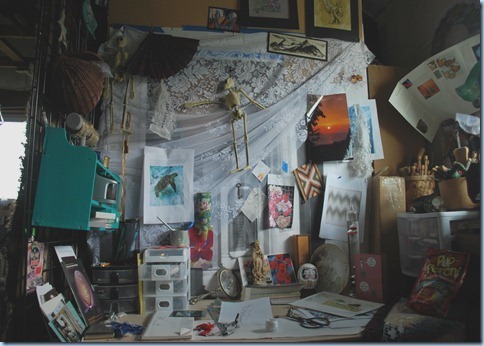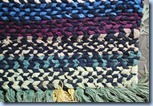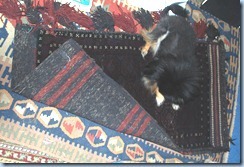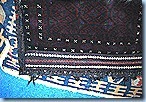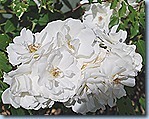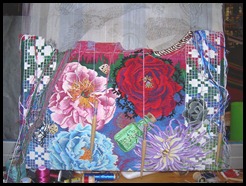
Lately, I seem to be continua ly surprising myself. In the last 2 weeks I have been on a Family trip to the Bay area, managed to weave more then I thought I would be able to, attended a Marc Adam’s Symposium-that I am still digesting, and managed
ly surprising myself. In the last 2 weeks I have been on a Family trip to the Bay area, managed to weave more then I thought I would be able to, attended a Marc Adam’s Symposium-that I am still digesting, and managed  to run through 5 major museums with Grandsons in tow+ Alcatraz-managed to sun burn my neck and back through 4 layers of T-shirt, scarf and heavy sports bra. Loved every second of it. My favourite place was the oh-so, tacky,unbelievable, so ethnocentric, confounding, laughable, mindboggling wax museum on Fisherman's Wharf. I thought I would never stop laughing and just being amazed about how these people were portrayed and sitting in front of Da Vinci’s last supper discussing it with Troy.
to run through 5 major museums with Grandsons in tow+ Alcatraz-managed to sun burn my neck and back through 4 layers of T-shirt, scarf and heavy sports bra. Loved every second of it. My favourite place was the oh-so, tacky,unbelievable, so ethnocentric, confounding, laughable, mindboggling wax museum on Fisherman's Wharf. I thought I would never stop laughing and just being amazed about how these people were portrayed and sitting in front of Da Vinci’s last supper discussing it with Troy.
 One evening in Alameda we went to see the Avengers with the Grandkids. Loved the renovated Alameda theater and all of the Art Deco frills that have been restored. It was designed by Timothy Ludwig Pflueger and
One evening in Alameda we went to see the Avengers with the Grandkids. Loved the renovated Alameda theater and all of the Art Deco frills that have been restored. It was designed by Timothy Ludwig Pflueger and  built in 1932. I found that I have grown a little rusty on my comic book trivia. Spencer, of Alcatraz course, knows everything possible to know about Spiderman. Major mistake on my part- Gotham City is Batman not Spiderman. Spiderman is NYC and DC not Marvel. I spent one evening on my I- pad researching old comic book hero's and heroines as a refresher. Alameda Theater
built in 1932. I found that I have grown a little rusty on my comic book trivia. Spencer, of Alcatraz course, knows everything possible to know about Spiderman. Major mistake on my part- Gotham City is Batman not Spiderman. Spiderman is NYC and DC not Marvel. I spent one evening on my I- pad researching old comic book hero's and heroines as a refresher. Alameda Theater
Another Life time Ago:
The trivial amount of research brought back a lot of old thoughts and corundum's about my childhood. I wasn’t allowed to read fiction or see comic books. I later discovered the Public Library and realized that when I was home no one checked up on what I was reading and/or if the school and/or church approved or disapproved.
| 

| The Black Widow-from Wikipedia and Stan Lee, Don Rico; Tales of Suspense #52.First costume (and bouffant hairdo). From The Avengers #36 (Jan. 1967), art by Don Heck; Marvel Comics. By the time I pretty much grew up and went to WWC Natalya Romanov had the most incredible wardrobe imaginable-drawn, sewn and designed by me. Also borrowed from Wikipedia,1962;Journey into Mystery; marvel comics;created by Stan Lee, Larry Lieber, Jack Kirby |
I wasn’t allowed to read comic books when I was growing up-religious thing- again. BUT, my father had a hidden collection of comic books on the top shelf of the linen cl oset. I could just reach it if I stood on top of the space heater and didn’t tip the box too far so that it spilled into the bath tub. Those comic books fueled my love for animation and art that eventually lead to tapestry and the stylization that of my designs that I so love... I always wondered if he knew
oset. I could just reach it if I stood on top of the space heater and didn’t tip the box too far so that it spilled into the bath tub. Those comic books fueled my love for animation and art that eventually lead to tapestry and the stylization that of my designs that I so love... I always wondered if he knew  because I dropped a couple in the bath tub and put
because I dropped a couple in the bath tub and put
Dad and Spike them away wet.
long road to nowhere and back
It was odd being nailed for reading Ivanhoe and Kenilworth by Scott and having to stay after school cleaning bathrooms as a penalty for reading the wrong book. I was in the 4th grade at the time. When I did get caught it was heavily suggested to my parents that they should monitor my behaviour a little closer and come up with a fitting punishment.Usually more house work-not for reading-but the fact I shamed my parents by being called into the principals office.
I can still remember at a revival one of the Ministers suggesting that I would never reach heaven at the second coming until I gave up my reading habits in front of 500 or 600 persons at the meeting. I had been caught under the stairwell reading an  illicit book while hiding out from the revival meeting I was forced to attend as a school assignment by Mrs. Harrington and Mrs. Maclean-4th and 5th grade. Mrs. Winters(English teacher-academy) did catch on many years later and encouraged by choosing to ignore it all.
illicit book while hiding out from the revival meeting I was forced to attend as a school assignment by Mrs. Harrington and Mrs. Maclean-4th and 5th grade. Mrs. Winters(English teacher-academy) did catch on many years later and encouraged by choosing to ignore it all.
Thor-the comic book guy-fueled my interest in mythology another forbidden interest when I was growing up. The comic books led me to research other things and a particular drawing style. Yea, probably not the best source, but My father gave me an Encyclopedia Britannica-Collegiate when I was in the second grade to help me with my home work. I blessed the door to door salesman a thousand/ million times when I was growing up. Not only did I have the info to thumb through, but he showed me how to use an index. Totally low tech!
Serious stuff now-Tapestry Tech...

I think this section I am weaving best illustrates what soumack is all about in pictorial tapestry-at least for me.
Soumack is basically done in 3 forms.
1. There is is what I call structural soumack, which is done along a fell line and becomes part of the weaving or the weaving itself. Best examples are Middle Eastern rugs and bags rugs. Which is the patterned stripe in this picture. It actually becomes part of the main  structure of the tapestry and is woven over by ensuing passes of plain weave or tapestry.Note in my sample above it is being done along the quill and shaft of the feather and around almost all of the petals of the flowers. The fell line is actually moving up at an angle that will support the lines of soumack that will create the quill and the shaft.
structure of the tapestry and is woven over by ensuing passes of plain weave or tapestry.Note in my sample above it is being done along the quill and shaft of the feather and around almost all of the petals of the flowers. The fell line is actually moving up at an angle that will support the lines of soumack that will create the quill and the shaft.
To construct these lines I could have used an eccentric weft, but this would have created to problems I wanted to avoid. It would have increased the length of the float between two warps and perhaps looked loopy and created odd bulges along the shaft of the feather as the distance between warps became greater as the angle of the fell line increased as the angle of the fell line became greater. I REALLY NEEDD TO DIND SOME PICTURES OF THIS PROBLEM BEFORE I TEACH THIS CLASS AGAIN(#reminder to self). The second option would have used many short burst of eccentric weaving along the fell line and would still/could have a truncated bump or a very small slit between each new pass as it turned interrupting the smoothness of the line I was trying to weave.. Again increasing the chance of a loopy bumpy look as the passes traveled up the fell line.
The biggest problem to deal with is that inherent in the eccentric weave structure is the problem of tension control and the chance of pull in on a steep angle somewhere in the tapestry as it is beaten down. It is almost impossible when doing several eccentric passes to use enough weft to both cover the warps and not create pull in problems as you continue to the weave the tapestry. The bubble has to be horrendously large and looks really terrible as you weave it in order to compensate when beaten against in future passes. The problems would most like become apparent many passes up from the original lines of eccentric weaving as areas of warp are pulled closer together. and the sides could pull in drastically closest to the end of the eccentric pass. You would then need to un weave and try again or choose another technique-anyway or accept the problem.
By using structural soumack I can make the line look smoother then a woven line unless I split the weft which also would be too eccentric as it covers the 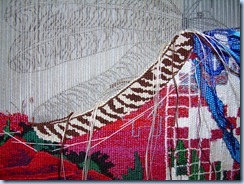 hills and valleys of the turns along the fell line. I still need to carefully watch for pull in, but it is much more apparent and easier to correct then eccentric weaving. Where I place it it stays and one turn usually only controls the distance between 2 wraps of soumack. I can apply pressure to unsmooth places along the soumack and/or smooth the angle. Because of the nature of structural soumack. It doesn’t cause problems further up the weaving. Each twist of the soumack locks the line of soumack into place. The other great thing about this type of soumack is it creates neutral shed and is a neutral shed.No problem with unruly wefts ending in the wrong shed and needing to be changed.
hills and valleys of the turns along the fell line. I still need to carefully watch for pull in, but it is much more apparent and easier to correct then eccentric weaving. Where I place it it stays and one turn usually only controls the distance between 2 wraps of soumack. I can apply pressure to unsmooth places along the soumack and/or smooth the angle. Because of the nature of structural soumack. It doesn’t cause problems further up the weaving. Each twist of the soumack locks the line of soumack into place. The other great thing about this type of soumack is it creates neutral shed and is a neutral shed.No problem with unruly wefts ending in the wrong shed and needing to be changed.
The other advantage is by controlling the size of the soumack weft bundle I can control the thickness of the line. In the brown and white soumack lines I am using 6 weft threads to create the major out lines of the shaft. The inside of the shaft or white is a pointed thinning line that thickens as it rises up the fell line. So in order to get the transition from smaller to larger, I started out with 2 threads of white in the pointed end then switched to 4 and then 6. in the first white layer of soumack. As I twine up the shaft with my initial 2 threads I can the soumack over the next layers of soumack by increasing the thickness with the over lay of the 2 soumack wefts on top of the larger bundles of soumack weft.
2.The second type of soumack is what I call a floating soumack or a vertical soumack. It rides on the surface of the tapestry floating over the tapestry wefts. The vertical grids in the lace on is this type of soumack. It is only controlled by the warps. Floating vertical soumack was used in the puzzle pieces and heart beat lines in red. In Too Little Too Late structural soumack was used on to create straight lines along many of the shapes. You can make the floating line thicker or thinner in look by going over one weft passes or fewer weft passes. SO, it is controlled by the warp and the length of the float to the next warp. It’s great for drawing very fine lines and outlines on the surface of a
wefts. The vertical grids in the lace on is this type of soumack. It is only controlled by the warps. Floating vertical soumack was used in the puzzle pieces and heart beat lines in red. In Too Little Too Late structural soumack was used on to create straight lines along many of the shapes. You can make the floating line thicker or thinner in look by going over one weft passes or fewer weft passes. SO, it is controlled by the warp and the length of the float to the next warp. It’s great for drawing very fine lines and outlines on the surface of a tapestry. The one thing one needs to watch is that vertical soumack is either right handed or left handed depending on the directions of the turn. What one needs to watch when using this form of Soumack is the size of the weft bundle. I purposely used larger weft bundles in the detail of Pax Chene to create texture and the soft look of the chenille bedspread. Generally to make the surface feel flat to the touch and so it doesn’t make a shadow is half of the weft bundle.
tapestry. The one thing one needs to watch is that vertical soumack is either right handed or left handed depending on the directions of the turn. What one needs to watch when using this form of Soumack is the size of the weft bundle. I purposely used larger weft bundles in the detail of Pax Chene to create texture and the soft look of the chenille bedspread. Generally to make the surface feel flat to the touch and so it doesn’t make a shadow is half of the weft bundle.
3.The third type of soumack is called long jump soumack. I have seen it in Turkish textiles the jumps between warps can be an inch or more and it is done very closely together across the fell line and creates a brocaded effect and a satiny look. Will discuss this next time as I start doing my handouts for a brocading class I am teaching-maybe-for a workshop that is still trying to decide which workshop they wish me to teach.

Chene is growing testy and bored and needs a walk!
Take care!
kathe
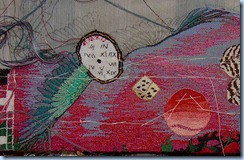 Most all of the soumack outlining in the feathers is structural Soumack which means it is done along a fell line even if it is an eccentric fell line.
Most all of the soumack outlining in the feathers is structural Soumack which means it is done along a fell line even if it is an eccentric fell line. 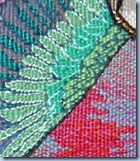 can go diagonally, horizontally or vertically. It can zig zag back and forth over a solid area of weaving. Not the example of the back and forth in the pale green area next to the dark soumack line which is a structural soumack.
can go diagonally, horizontally or vertically. It can zig zag back and forth over a solid area of weaving. Not the example of the back and forth in the pale green area next to the dark soumack line which is a structural soumack.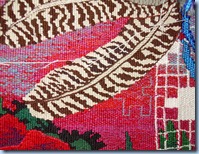 is both structural and vertical.
is both structural and vertical. 
